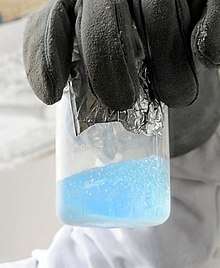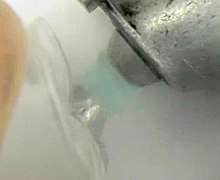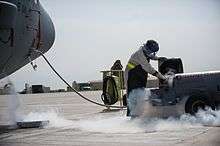Liquid oxygen
Liquid oxygen—abbreviated LOx, LOX or Lox in the aerospace, submarine and gas industries—is the liquid form of diatomic oxygen. It was used as the oxidizer in the first liquid-fueled rocket invented in 1926 by Robert H. Goddard[1], an application which has continued to the present.


Physical properties
Liquid oxygen has a pale blue color and is strongly paramagnetic: it can be suspended between the poles of a powerful +U- magnet (horseshoe).[2] Liquid oxygen has a density of 1.141 g/cm3 (1.141 kg/L or 1141 kg/m3), slightly denser than liquid water, and is cryogenic with a freezing point of 54.36 K (−218.79 °C; −361.82 °F) and a boiling point of 90.19 K (−182.96 °C; −297.33 °F) at 101.325 kPa (760 mmHg). Liquid oxygen has an expansion ratio of 1:861 under 1 standard atmosphere (100 kPa) and 20 °C (68 °F),[3][4] and because of this, it is used in some commercial and military aircraft as a transportable source of breathing oxygen.
Because of its cryogenic nature, liquid oxygen can cause the materials it touches to become extremely brittle. Liquid oxygen is also a very powerful oxidizing agent: organic materials will burn rapidly and energetically in liquid oxygen. Further, if soaked in liquid oxygen, some materials such as coal briquettes, carbon black, etc., can detonate unpredictably from sources of ignition such as flames, sparks or impact from light blows. Petrochemicals, including asphalt, often exhibit this behavior.[5]
The tetraoxygen molecule (O4) was first predicted in 1924 by Gilbert N. Lewis, who proposed it to explain why liquid oxygen defied Curie's law.[6] Modern computer simulations indicate that, although there are no stable O4 molecules in liquid oxygen, O2 molecules do tend to associate in pairs with antiparallel spins, forming transient O4 units.[7]
Liquid nitrogen has a lower boiling point at −196 °C (77 K) than oxygen's −183 °C (90 K), and vessels containing liquid nitrogen can condense oxygen from air: when most of the nitrogen has evaporated from such a vessel there is a risk that liquid oxygen remaining can react violently with organic material. Conversely, liquid nitrogen or liquid air can be oxygen-enriched by letting it stand in open air; atmospheric oxygen dissolves in it, while nitrogen evaporates preferentially.
The surface tension of liquid oxygen at its normal pressure boiling point is 13.2 dynes/cm.[8]
Uses

In commerce, liquid oxygen is classified as an industrial gas and is widely used for industrial and medical purposes. Liquid oxygen is obtained from the oxygen found naturally in air by fractional distillation in a cryogenic air separation plant.
Air forces have long recognized the strategic importance of liquid oxygen, both as an oxidizer and as a supply of gaseous oxygen for breathing in hospitals and high-altitude aircraft flights. In 1985 the USAF started a program of building its own oxygen-generation facilities at all major consumption bases.[10][11]
In rocket propellant
Liquid oxygen is the most common cryogenic liquid oxidizer propellant for spacecraft rocket applications, usually in combination with liquid hydrogen, kerosene or methane.[12][13]
Liquid oxygen was used in the first liquid fueled rocket. The World War II V-2 missile also used liquid oxygen under the name A-Stoff and Sauerstoff. In the 1950s, during the Cold War both the United States' Redstone and Atlas rockets, and the Soviet R-7 Semyorka used liquid oxygen. Later, in the 1960s and 1970s, the ascent stages of the Apollo Saturn rockets, and the Space Shuttle main engines used liquid oxygen.
In 2020, many rockets use liquid oxygen:
- Chinese space program: Long March 5, and its derivations Long March 6, Long March 7
- Indian Space Research Organisation: GSLV
- JAXA (Japan): H-IIA and H3 (under development)
- Roscosmos (Russia): Soyuz-2 and Angara (under development)
- ESA (EU): Ariane 5 and Ariane 6 (under development)
- United States
- SpaceX: Falcon 9, Falcon Heavy and Starship (under development) (liquid oxygen chilled to ~ 66 K (−207.2 °C; −340.9 °F), 10% denser than at boiling temperature)
- United Launch Alliance: Atlas V, Delta IV, Delta IV Heavy, Vulcan (under development)
- Northrop Grumman: Antares 230+
- Blue Origin: New Shepard and New Glenn (under development)
- Rocket Lab: Electron
- Firefly Aerospace: Firefly Alpha (under development)
- Virgin Orbit: LauncherOne (under development)
History
- By 1845, Michael Faraday had managed to liquefy most gases then known to exist. Six gases, however, resisted every attempt at liquefaction[14] and were known at the time as "permanent gases". They were oxygen, hydrogen, nitrogen, carbon monoxide, methane, and nitric oxide.
- In 1877, Louis Paul Cailletet in France and Raoul Pictet in Switzerland succeeded in producing the first droplets of liquid air.
- In 1883, Polish professors Zygmunt Wróblewski and Karol Olszewski produced the first measurable quantity of liquid oxygen.
See also
| Wikimedia Commons has media related to Liquid oxygen. |
- Oxygen storage
- Industrial gas
- Cryogenics
- Liquid hydrogen
- Liquid helium
- Liquid nitrogen
- List of Stoffs
- Natterer compressor
- Rocket fuel
- Solid oxygen
- Tetraoxygen
References
- Editors, History com. "First liquid-fueled rocket". HISTORY. Retrieved 2019-03-16.CS1 maint: extra text: authors list (link)
- Moore, John W.; Stanitski, Conrad L.; Jurs, Peter C. (21 January 2009). Principles of Chemistry: The Molecular Science. Cengage Learning. pp. 297–. ISBN 978-0-495-39079-4. Retrieved 3 April 2011.
- Cryogenic Safety. chemistry.ohio-state.edu.
- Characteristics Archived 2012-02-18 at the Wayback Machine. Lindecanada.com. Retrieved on 2012-07-22.
- "Liquid Oxygen Receipt, Handling, Storage and Disposal". USAF Training Film.
- Lewis, Gilbert N. (1924). "The Magnetism of Oxygen and the Molecule O2". Journal of the American Chemical Society. 46 (9): 2027–2032. doi:10.1021/ja01674a008.
- Oda, Tatsuki; Alfredo Pasquarello (2004). "Noncollinear magnetism in liquid oxygen: A first-principles molecular dynamics study" (PDF). Physical Review B. 70 (134402): 1–19. Bibcode:2004PhRvB..70m4402O. doi:10.1103/PhysRevB.70.134402.
- https://ntrs.nasa.gov/archive/nasa/casi.ntrs.nasa.gov/20110014531.pdf J.M. Jurns and J.W. Hartwig (2011). Liquid Oxygen Liquid Acquisition Device Bubble Point Tests With High Pressure LOX at Elevated Temperatures, p.4
- Cryo Techs: Providing the breath of life. af.mil (2014-09-05)
- Arnold, Mark. 1U.S. Army Oxygen Generation System Development. RTO-MP-HFM-182. dtic.mil
- Timmerhaus, K. D. (8 March 2013). Advances in Cryogenic Engineering: Proceedings of the 1957 Cryogenic Engineering Conference, National Bureau of Standards Boulder, Colorado, August 19–21, 1957. Springer Science & Business Media. pp. 150–. ISBN 978-1-4684-3105-6.
- Belluscio, Alejandro G. (March 7, 2014). "SpaceX advances drive for Mars rocket via Raptor power". NASAspaceflight.com. Retrieved March 13, 2014.
- Todd, David (November 20, 2012). "Musk goes for methane-burning reusable rockets as step to colonise Mars". FlightGlobal Hyperbola. Archived from the original on November 28, 2012. Retrieved November 22, 2012.
‘We are going to do methane,’ Musk announced as he described his future plans for reusable launch vehicles including those designed to take astronauts to Mars within 15 years, ‘The energy cost of methane is the lowest and it has a slight Isp (Specific Impulse) advantage over Kerosene’ said Musk adding, ‘and it does not have the pain in the ass factor that hydrogen has.’ ... SpaceX's initial plan will be to build a lox/methane rocket for a future upper stage codenamed Raptor. ... The new Raptor upper stage engine is likely to be only the first engine in a series of lox/methane engines.
- Cryogenics. Scienceclarified.com. Retrieved on 2012-07-22.